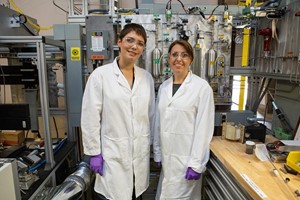News
NETL partnership develops improved ammonia production process
When NETL researchers teamed up with colleagues at West Virginia University (WVU) and Malachite Technologies, their mission was to improve on a process that has dominated ammonia production for more than 100 years by producing the valuable chemical at low temperatures and near-ambient pressures. The team found success by combining cutting-edge microwave reaction science research at NETL with specialized catalyst development from WVU and reactor manufacturing experience from Malachite to create the award-winning Microwave Ammonia Synthesis (MAS) process.
“The MAS process is unique because it is based on microwave catalysis,” said NETL’s Dushyant Shekhawat. “Conventional reaction processes like the Haber-Bosch process have been reliably used for a century, but it relies on conduction, convection and radiation and requires heating of the vessel containing the catalyst at high pressures to synthesize ammonia and other products. Conversely, microwaves transfer energy to materials differently, selectively heating the catalyst directly.”
Selective heating translates to less energy required for the entire process, less material needed to insulate the large reactor vessels and less metal used to contain the high pressures. Consequently, capital investment costs, operating costs and energy consumption are all reduced. NETL’s new technology, because it does not require the massive heaters and compressors of the Haber-Bosch process, can operate on intermittent power sources, such as wind or solar, enabling greater flexibility and decentralized deployment.
“The Haber-Bosh process also contributes significantly to the world’s carbon dioxide (CO2) emissions, whereas the MAS process is energy efficient, cost effective and capable of using intermittent renewable power,” Shekhawat said. “We have demonstrated the process in terms of reaction efficiency and have shown that the process, with its almost instant turn-on capability, will meet the needs of small, distributed production sites that may need to stop operation when the sun sets or the wind stops.”
The MAS process also has the potential of modularity, so smaller-scale ammonia plants could be built to local specifications, allowing for flexibility in their use. Consequently, distributed modular fertilizer plants could be located near renewable resources and the farms that use them. For example, Iowa has access to numerous wind farms that could supply renewable energy to generate microwave energy to produce ammonia for use by neighboring farms. This design would eliminate the need for energy transmission as well as transportation of ammonia for farms across great distances.
While fertilizer production is the most common end-use of ammonia, the chemical can also be used as a hydrogen carrier, which will increase in importance as the nation transitions to a clean hydrogen economy. Ammonia can also be used as a carbon-neutral liquid fuel in power generation, which has already been demonstrated by certain European power plants. Other uses of ammonia include refrigerant gas, purification of water supplies and the manufacture of plastics, textiles, dyes, household and industrial-strength cleaning solutions, and other chemicals.
“We still have more work to do on this promising technology,” Shekhawat said. “At the moment, the Haber-Bosch process still offers great efficiencies at large scale, but we are working hard to scale up our MAS process, and if it is optimized and adopted on a large scale, it could have a positive economic impact by meeting the demand for the construction of renewable energy plants and infrastructure while lowering the costs of agricultural production and CO2 emissions.”


